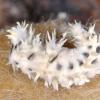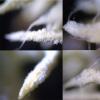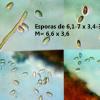
21-12-2025 09:32
Hello.A tiny ascomycete found embedded in wood in

21-12-2025 21:32
Pol DebaenstHello, Garden, Burgweg 19, Veurne, BelgiumOn 10/1

22-12-2025 23:38
Patrice TANCHAUDBonsoir, récolte sur un mur en pierre, apothéci

22-12-2025 00:47
Patrice TANCHAUDBonsoir, récolte à proximité du milieu dunaire

21-12-2025 21:40
Isabelle CharissouBonjour, j'aimerais connaitre les références de

21-12-2025 21:31
Pol DebaenstHello, Garden, Burgweg 19, Veurne, BelgiumOn 10/1

21-12-2025 21:31
Pol DebaenstHello, Garden, Burgweg 19, Veurne, BelgiumOn 10/1

20-12-2025 23:08
Patrice TANCHAUDBonsoir, récolte sur sol sablonneux dans l'arri�
En luciernaga (Lampyridae)
Castillo Joseba,
21-06-2016 09:14
A ver si hay alguna sugerencia
Saludos
Joseba
Walter Gams,
21-06-2016 09:23
Re : En luciernaga (Lampyridae)
Apreciado Joseba,
Your last picture suggests that you have Isaria farinosa, which tends to make synnemata. Are the brown spines that you illustrate part of the fungus? Then they may be a beginnng ascostroma of the Cordyceps teleomorph, which is quite rare. Regards Walter
Your last picture suggests that you have Isaria farinosa, which tends to make synnemata. Are the brown spines that you illustrate part of the fungus? Then they may be a beginnng ascostroma of the Cordyceps teleomorph, which is quite rare. Regards Walter
Castillo Joseba,
21-06-2016 09:42
Re : En luciernaga (Lampyridae)
Hola Walter... la ultima parte de tu contestación no la entiendo ...
"Then they may be a beginnng ascostroma of the Cordyceps teleomorph, which is quite rare."
Quiza me dices que hay un Cordyceps oculto bajo la Isaria farinosa?
Saludos
Joseba
"Then they may be a beginnng ascostroma of the Cordyceps teleomorph, which is quite rare."
Quiza me dices que hay un Cordyceps oculto bajo la Isaria farinosa?
Saludos
Joseba
Walter Gams,
21-06-2016 17:41
Re : En luciernaga (Lampyridae)
Isaria farinosa is known to have a teleomorph, Cordyces memorabilis.Ceaati 1861, but it has been recorded in the last century only by Pacioni & Frizzi in 1978. Thus a fungus with 2 different morphs. Best regards Walter





